初中动词不定式和动名词用法总结
- 格式:doc
- 大小:33.00 KB
- 文档页数:2

动词不定式与动名词用法总结一动词不定式作主语(1) (1)To learn a foreign language is not easy.主语It(形式主语)is not easy to learn a foreign language(真正主语)It takes / took me 3 hours to read EnglishIt is not difficult for us to learn a foreign languageIt’s kind of you to help me with my English .1 It+is+形容词(表示人的性格品质)+of sb+to do2 It+is+形容词(表示做某事是怎么样)+for sb+to do注(1)当形容词表示人的性格品质时,逻辑主语由of引出,如:kind,nice, good, polite, clever, careful,careless, foolish,(2)当形容词表示做某事是怎么样时逻辑主语由for引出.如:difficult, hard , easy, important, dangerous possible二动词不定式宾语此种情况可按固定搭配或句式去记。
want to do agree to do hope to do decideto doprefer to do plan to do offer to do would like to doKevin planned to visit his uncle三动词不定式做宾语补足语tell sb + to do ask sb + to do want sb +to doorder sb + to do invite sb + to do warn sb+ to doI tell him not to go there by bus .四:定语动词不定式做定语放在所修饰的名词、代词的后面。
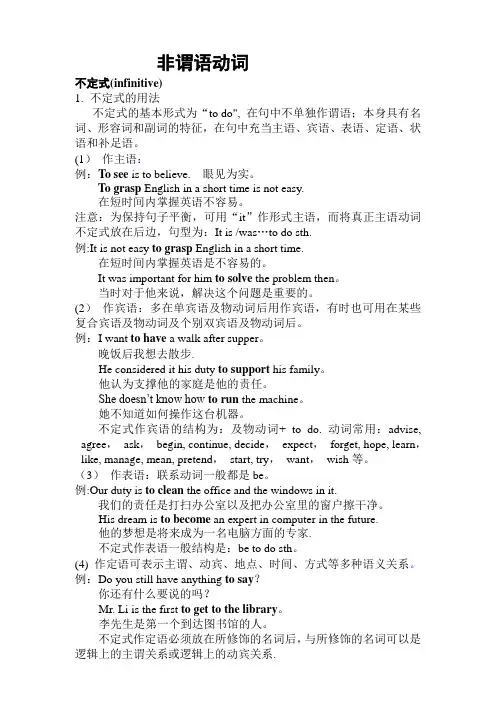
非谓语动词不定式(infinitive)1.不定式的用法不定式的基本形式为“to do", 在句中不单独作谓语;本身具有名词、形容词和副词的特征,在句中充当主语、宾语、表语、定语、状语和补足语。
(1)作主语:例:To see is to believe. 眼见为实。
To grasp English in a short time is not easy.在短时间内掌握英语不容易。
注意:为保持句子平衡,可用“it”作形式主语,而将真正主语动词不定式放在后边,句型为:It is /was…to do sth.例:It is not easy to grasp English in a short time.在短时间内掌握英语是不容易的。
It was important for him to solve the problem then。
当时对于他来说,解决这个问题是重要的。
(2)作宾语:多在单宾语及物动词后用作宾语,有时也可用在某些复合宾语及物动词及个别双宾语及物动词后。
例:I want to have a walk after supper。
晚饭后我想去散步.He considered it his duty to support his family。
他认为支撑他的家庭是他的责任。
She doesn’t know how to run the machine。
她不知道如何操作这台机器。
不定式作宾语的结构为:及物动词+ to do. 动词常用:advise, agree,ask,begin, continue, decide,expect,forget, hope, learn,like, manage, mean, pretend,start, try,want,wish等。
(3)作表语:联系动词一般都是be。
例:Our duty is to clean the office and the windows in it.我们的责任是打扫办公室以及把办公室里的窗户擦干净。
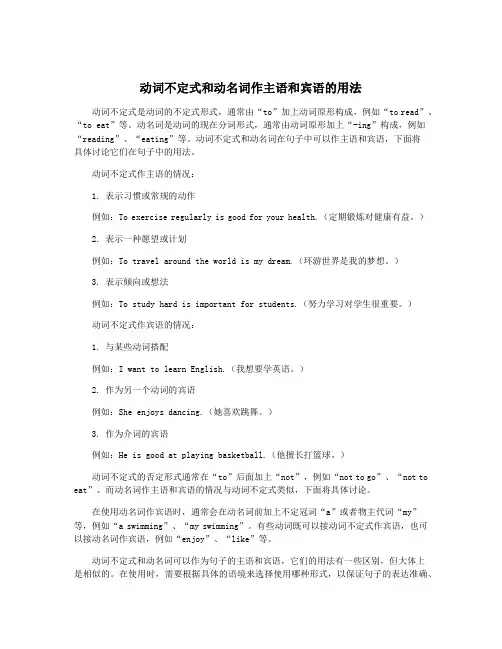
动词不定式和动名词作主语和宾语的用法动词不定式是动词的不定式形式,通常由“to”加上动词原形构成,例如“to read”、“to eat”等。
动名词是动词的现在分词形式,通常由动词原形加上“-ing”构成,例如“reading”、“eating”等。
动词不定式和动名词在句子中可以作主语和宾语,下面将具体讨论它们在句子中的用法。
动词不定式作主语的情况:1. 表示习惯或常规的动作例如:To exercise regularly is good for your health.(定期锻炼对健康有益。
)2. 表示一种愿望或计划例如:To travel around the world is my dream.(环游世界是我的梦想。
)3. 表示倾向或想法例如:To study hard is important for students.(努力学习对学生很重要。
)动词不定式作宾语的情况:1. 与某些动词搭配例如:I want to learn English.(我想要学英语。
)2. 作为另一个动词的宾语例如:She enjoys dancing.(她喜欢跳舞。
)3. 作为介词的宾语例如:He is good at playing basketball.(他擅长打篮球。
)动词不定式的否定形式通常在“to”后面加上“not”,例如“not to go”、“not to eat”。
而动名词作主语和宾语的情况与动词不定式类似,下面将具体讨论。
在使用动名词作宾语时,通常会在动名词前加上不定冠词“a”或者物主代词“my”等,例如“a swimming”、“my swimming”。
有些动词既可以接动词不定式作宾语,也可以接动名词作宾语,例如“enjoy”、“like”等。
动词不定式和动名词可以作为句子的主语和宾语,它们的用法有一些区别,但大体上是相似的。
在使用时,需要根据具体的语境来选择使用哪种形式,以保证句子的表达准确、清晰。
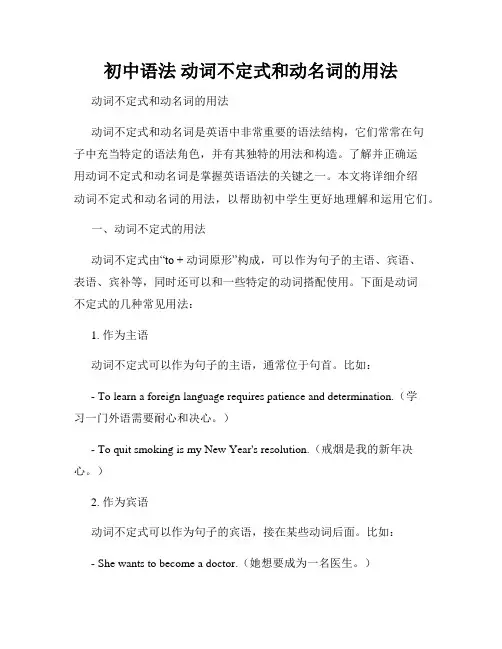
初中语法动词不定式和动名词的用法动词不定式和动名词的用法动词不定式和动名词是英语中非常重要的语法结构,它们常常在句子中充当特定的语法角色,并有其独特的用法和构造。
了解并正确运用动词不定式和动名词是掌握英语语法的关键之一。
本文将详细介绍动词不定式和动名词的用法,以帮助初中学生更好地理解和运用它们。
一、动词不定式的用法动词不定式由“to + 动词原形”构成,可以作为句子的主语、宾语、表语、宾补等,同时还可以和一些特定的动词搭配使用。
下面是动词不定式的几种常见用法:1. 作为主语动词不定式可以作为句子的主语,通常位于句首。
比如:- To learn a foreign language requires patience and determination.(学习一门外语需要耐心和决心。
)- To quit smoking is my New Year's resolution.(戒烟是我的新年决心。
)2. 作为宾语动词不定式可以作为句子的宾语,接在某些动词后面。
比如:- She wants to become a doctor.(她想要成为一名医生。
)- He enjoys playing basketball.(他喜欢打篮球。
)3. 作为表语动词不定式可以作为句子的表语,通常与be动词连用。
比如:- His dream is to travel around the world.(他的梦想是周游世界。
)- The most important thing is to believe in yourself.(最重要的事情是相信自己。
)4. 作为宾补某些动词后面可以接动词不定式作为宾补,表示动作的目的、结果或意图。
比如:- He wants to buy a new car.(他想要买一辆新车。
)- I need to finish my homework before dinner.(我需要在晚餐前完成我的作业。

初中英语知识点归纳动词的不定式和动名词用法总结动词的不定式和动名词是英语学习中的重要知识点,它们的用法十分多样且常见。
本文将对动词的不定式和动名词的用法进行总结和归纳。
一、动词不定式1. 作主语:例句:To succeed in life is his ultimate goal.成功是他追求的终极目标。
2. 作宾语:a. 接及物动词的宾语:例句:I want to learn English.我想学英语。
b. 接不及物动词的宾语:例句:She decided to go hiking.她决定去徒步旅行。
3. 作表语:例句:Her dream is to become a doctor.她的梦想是成为一名医生。
4. 作补语:a. 表示命令、建议、请求等:例句:She told me to wait for her at the gate.她告诉我在门口等她。
b. 表示目的、目标等:例句:He went to the store to buy some groceries.他去商店买一些杂货。
5. 作定语:例句:We need a person to help us with the project.我们需要一个人来帮助我们完成这个项目。
6. 作状语:a. 表示目的、结果、原因等:例句:He studied hard to pass the exam.他努力学习为了通过考试。
b. 表示时间、条件等:例句:I woke up early to catch the bus.我早起为了赶公交车。
二、动名词1. 作主语:例句:Swimming is my favorite sport.游泳是我最喜欢的运动。
2. 作宾语:例句:I enjoy reading books in my free time.我喜欢在空闲时间读书。
3. 作表语:例句:Her hobby is dancing.她的爱好是跳舞。
4. 作补语:例句:His job is teaching English.他的工作是教英语。
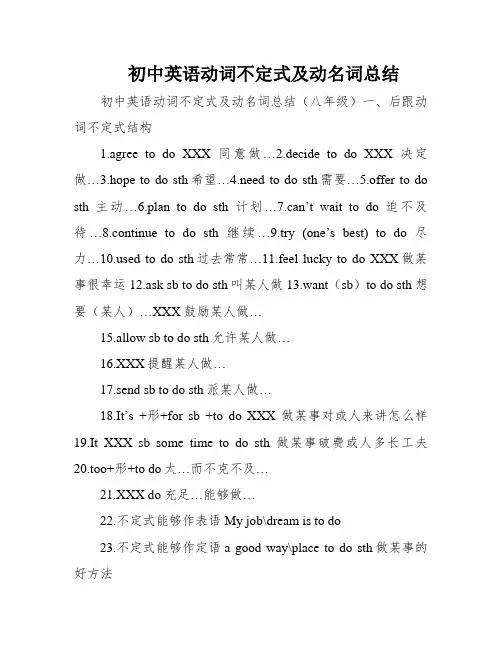
初中英语动词不定式及动名词总结初中英语动词不定式及动名词总结(八年级)一、后跟动词不定式结构1.agree to do XXX同意做…2.decide to do XXX决定做…3.hope to do sth希望…4.need to do sth需要…5.offer to do sth主动…6.plan to do sth计划…7.can’t wait to do迫不及待…8.continue to do sth继续…9.try (one’s best) to do尽力…ed to do sth过去常常…11.feel lucky to do XXX做某事很幸运12.ask sb to do sth叫某人做13.want(sb)to do sth想要(某人)…XXX鼓励某人做…15.allow sb to do sth允许某人做…16.XXX提醒某人做…17.send sb to do sth派某人做…18.It’s +形+for sb +to do XXX做某事对或人来讲怎么样19.It XXX sb some time to do sth做某事破费或人多长工夫20.too+形+to do太…而不克不及…21.XXX do充足…能够做…22.不定式能够作表语My job\dream is to do23.不定式能够作定语a good way\place to do sth做某事的好方法24.不定式能够表目的To get good grades。
I must study hard2、后跟动名词方式1.consider doing sth考虑2.XXX喜爱3.XXX XXX做完某事4.mind doing sth介意5.keep doing sth一直keep on doing sth继续|坚持6.can’t。
doing sth停不下来7.can’t。
help doing sth不由得8.put off doing sth推迟9.give up XXX摒弃10.ba busy doing sth忙于11.have a good time doing XXX做某事很开心12.have XXX做某事很困那13.how \what about doing sth…怎么样14.XXX成功做15.XXX感谢做16.be XXX对做某事感乐趣be afraid of doing sth害怕be good at doing sth善于于XXX对做…自豪be used to doing sth惯于17.sb spend some time (in) doing sth18.XXX三.即可加to do又可加ing,但意思差别大XXX do XXX忘记要做某事(事情还未做)XXX遗忘做过某事(工作已做)XXX记得要做某事(事情还未做)XXX记得做过某事(事情已做)try to do XXX尽力去做某事XXX尝试做某事to do XXX停下了去做某事XXX停止做某事used to do XXX过去常常做某事be used to doing sth气于做某事四.后跟动词原型make sb do XXX使某人做某事let sb do XXX让某人做某事help sb (to) do sth帮助或人做某had better do XXX最好做某事五.便可跟原型,又可跟ingsee sb do XXX看见某人做了某事(事情已发生)XXX瞥见或人正在做某事(工作正在产生)hear sb do XXX听见或人…了(工作已产生)。
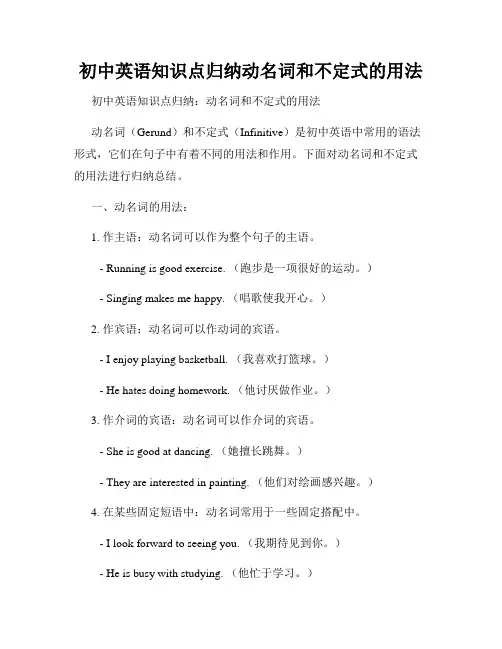
初中英语知识点归纳动名词和不定式的用法初中英语知识点归纳:动名词和不定式的用法动名词(Gerund)和不定式(Infinitive)是初中英语中常用的语法形式,它们在句子中有着不同的用法和作用。
下面对动名词和不定式的用法进行归纳总结。
一、动名词的用法:1. 作主语:动名词可以作为整个句子的主语。
- Running is good exercise. (跑步是一项很好的运动。
)- Singing makes me happy. (唱歌使我开心。
)2. 作宾语:动名词可以作动词的宾语。
- I enjoy playing basketball. (我喜欢打篮球。
)- He hates doing homework. (他讨厌做作业。
)3. 作介词的宾语:动名词可以作介词的宾语。
- She is good at dancing. (她擅长跳舞。
)- They are interested in painting. (他们对绘画感兴趣。
)4. 在某些固定短语中:动名词常用于一些固定搭配中。
- I look forward to seeing you. (我期待见到你。
)- He is busy with studying. (他忙于学习。
)5. 作宾补:动名词可以作及物动词的宾补。
- She found it interesting watching movies. (她认为看电影很有趣。
) - They made her captain of the team. (他们让她成为队长。
)二、不定式的用法:1. 作动词的宾语:不定式可以作动词的宾语。
- I want to study abroad. (我想出国留学。
)- He loves to play the piano. (他喜欢弹钢琴。
)2. 作形容词的定语:不定式可以作名词或代词的定语。
- This is a good book to read. (这是本值得阅读的好书。
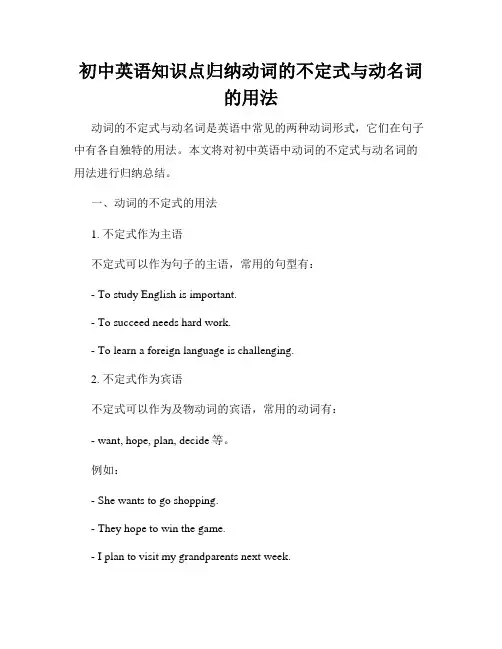
初中英语知识点归纳动词的不定式与动名词的用法动词的不定式与动名词是英语中常见的两种动词形式,它们在句子中有各自独特的用法。
本文将对初中英语中动词的不定式与动名词的用法进行归纳总结。
一、动词的不定式的用法1. 不定式作为主语不定式可以作为句子的主语,常用的句型有:- To study English is important.- To succeed needs hard work.- To learn a foreign language is challenging.2. 不定式作为宾语不定式可以作为及物动词的宾语,常用的动词有:- want, hope, plan, decide等。
例如:- She wants to go shopping.- They hope to win the game.- I plan to visit my grandparents next week.3. 不定式作为表语不定式也可以作为句子的表语,常用的句型有:- The best way to learn is to practice.- His dream is to become a doctor.- My goal is to travel around the world.4. 不定式作为状语不定式可以作为状语修饰动词、形容词或副词。
常用的句型有:- I woke up early to catch the train.- She was too tired to continue working.- He spoke slowly to make sure everyone understood.二、动名词的用法1. 动名词作为主语动名词可以作为句子的主语,常用的句型有:- Swimming is my favorite sport.- Reading books is a good way to relax.- Playing basketball requires teamwork.2. 动名词作为宾语动名词可以作为及物动词的宾语,常用的动词有:- enjoy, like, love, hate等。
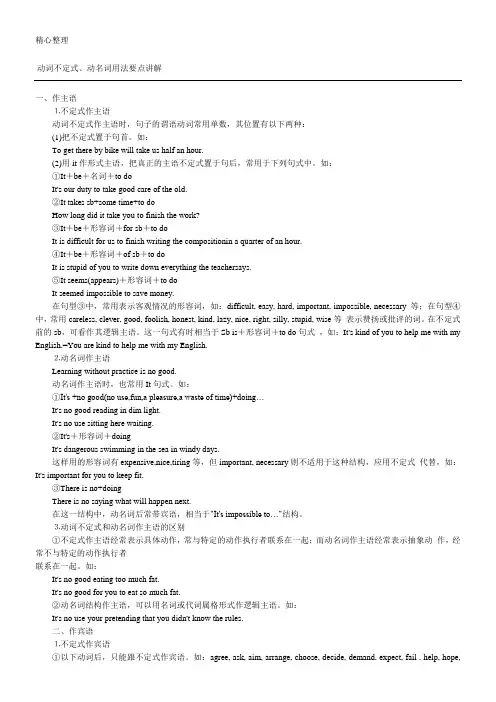
动词不定式、动名词用法要点讲解一、作主语⒈不定式作主语动词不定式作主语时,句子的谓语动词常用单数,其位置有以下两种:(1)把不定式置于句首。
如:To get there by bike will take us half an hour.(2)用it作形式主语,把真正的主语不定式置于句后,常用于下列句式中。
如:①It+be+名词+to doIt's our duty to take good care of the old.②It takes sb+some time+to doHow long did it take you to finish the work?③It+be+形容词+for sb+to doIt is difficult for us to finish writing the compositionin a quarter of an hour.④It+be+形容词+of sb+to doIt is stupid of you to write down everything the teachersays.⑤It seems(appears)+形容词+to doIt seemed impossible to save money.在句型③中,常用表示客观情况的形容词,如:difficult, easy, hard, important, impossible, necessary 等;在句型④中,常用careless, clever, good, foolish, honest, kind, lazy, nice, right, silly, stupid, wise等表示赞扬或批评的词。
在不定式前的sb,可看作其逻辑主语。
这一句式有时相当于Sb is+形容词+to do句式,如:It's kind of you to help me with my English.=You are kind to help me with my English.⒉动名词作主语Learning without practice is no good.动名词作主语时,也常用It句式。

初中英语动名词和动词不定式归纳初中英语动名词和动词不定式归纳一.Doing的用法1. 动词+doing(只能加doing的动词)Like/dislike/enjoy/have fun doing喜欢做consider doing考虑做mind (sb) doing介意做imagine doing 想象做suggest doing建议做practice doing练习做finish doing 结束做what about/ how about doing sth 做某事如何Thank you for doing sth. 为…感谢某人at the beginning of 的起初;……的开始keep/go/(on) /continue doing持续做can’t help doing情不自禁做can’t stand doing不能忍受做feel like doing想要做be busy doing 忙于做某事go +doing (go shopping) 去做某事no +doing禁止做某事be worth doing 值得做be busy doing sth 忙于做某事can’t stop doing sth 忍不住做某事spend time/money (in) doing 花费时间做某事waste time/money (in) doing浪费时间做某事consider doing sth 考虑做某事have trouble/ difficulty/ problems/ experience (in) doing 做某事有困难/有经验used to do 过去常常做某事be /get used for doing sth = be used todo sth.被用来作某事be/get/used to doing 习惯于做某事pay attention to doing 注意做某事hold onto doing sth 坚持做某事look forward to doing期望做某事be interested in doing=take an interest in doing对---感兴趣be good at doing sth= do well in doing sth.擅长作某事about: be worried about doing担忧做be embarrassed about 尴尬做be annoyed about 反感做be pleased with doing对做---满意prefer doing to doing宁愿—也不愿without: without doing没做from:stop sb (from) doing=prevent sb from doing=keep sb from doing阻止……做……(但keep sb doing使某人不停的做)by: by doing通过做二.动词+doing和todo 意义无大区别begin doing/ begin to dostart doing/ start to do开始做continue doing/to do持续做like doing / like to dolove doing / love to do 喜欢做hate doing/ hate to do讨厌做三.动词+doing和todo意义不同forget doing 忘记做过某事forget todo忘记去做某事(还未做)remember doing 记得做过某事remember to do记得要去做某事(还未做)stop doing=give up doing sth 停止做某事stop todo停下来去做另一件事try /tryone’s best to do尽力做need doing需要被做(主语指物)need todo 需要做(主语指人)四.动词+to doagree todo同意做want todo想要做would like to do想要做,愿意做decide to do决定做hope/wish to do希望做plan to do 计划做be supposed to sth =should do sth应该做某事learn todo学会做be /make sure to sth 确定做某事offer todo 主动要求做help (to)do /help sb with sth帮着做afford to do担负得起做refuse to do拒绝做regret to do 遗憾地做dare to do敢做seem to do似乎做promise to do许诺做can\'t wait to do迫不及待做pretend to do假装做used to do过去常常做get to do逐渐做have sth/nothing to do 有某事要做it’s one’sduty to do sth 做某事是某人的责任make up /change one’s mind to do sth.下定/改变某人决心做某事the way to do sth= the way of doing sth 做某方面的方法 . the way to +地方去哪的路其他用法:疑问词+ to dowhen/where/what/how/which/whether…to do形式主语:主语+think/feel/find…it+形容词+for(中性词).+to doit +形容词+of(褒/贬义词).+to dotoo+形容词+to do sth =not enough to do= so thatit takes sb. some time to do sth.be sorry/lucky/happy/glad/pleased to do很抱歉/开心幸运动词+sb.+to doallow sb to do 允许某人做某事get sb. to do 让某人做某事ask sb.to do 让某人做某事tell sb.to do 让某人做某事urge sb to do 争论做某事want/wouldlike sb. to do 想要做某事encourage sb. to do 鼓励某人做某事teach sb.to do 教某人做某事train sb.to do 训练某人做某事advises b. to do 建议做人某事lead sb.to do 领导某人做某事mislead sb. to do误导某人做invitesb. to do 邀请某人做某事expect sb. to do期待某人做remind sb. to do提醒某人做(但remind sb of doing使某人想起做过某事)五.动词+sb. + dosee /watch/hear/feel/noticesb do sth 看见/听见/感觉/注意某人做某事see/watch/hear/feel/notice sb doing sth 看见/听见/感觉/注意某人正在做某事其他不带to的不定式Why not do sth=why don’t do sth 为什么不做某事let sb do sth 让某人做某事make sb do sth 让某人做某事be made to dou sth 被迫做某事had better do最好做would rather do than do宁愿做某事而不厌做某事prefer to do rather than do宁愿做某事而不厌做某事情态动词+do动词原形will/would/can/may/might/must/should/shall+doto表示“的”作定语the key to the door 门的钥匙the key/answer to the question 问题的答案the solution to a problem 问题的解决the way to sp.去某地的路a+形容词+ place to do 一个做某事的地方a ticket to sp. (a ticket for + 比赛名称)一张什么的票句型;It’s time to do sth.It’s time for sth该作某事的时候了.动词做句子的主语,可用动名词ing可用不定式to do,一般用ing。
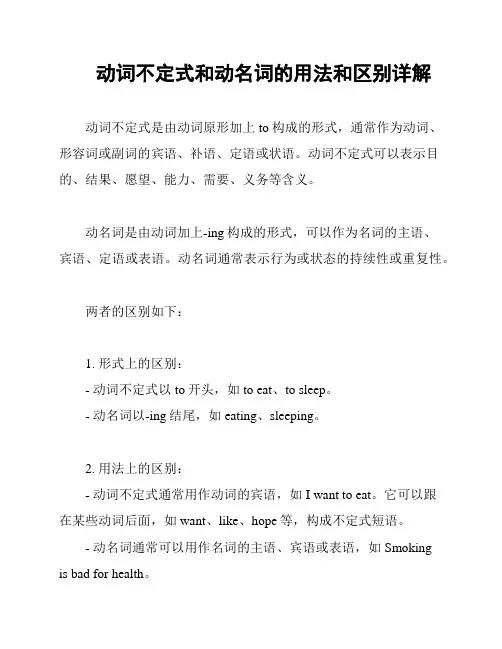
动词不定式和动名词的用法和区别详解动词不定式是由动词原形加上to构成的形式,通常作为动词、形容词或副词的宾语、补语、定语或状语。
动词不定式可以表示目的、结果、愿望、能力、需要、义务等含义。
动名词是由动词加上-ing构成的形式,可以作为名词的主语、宾语、定语或表语。
动名词通常表示行为或状态的持续性或重复性。
两者的区别如下:1. 形式上的区别:- 动词不定式以to开头,如to eat、to sleep。
- 动名词以-ing结尾,如eating、sleeping。
2. 用法上的区别:- 动词不定式通常用作动词的宾语,如I want to eat。
它可以跟在某些动词后面,如want、like、hope等,构成不定式短语。
- 动名词通常可以用作名词的主语、宾语或表语,如Smokingis bad for health。
3. 意义上的区别:- 动词不定式强调的是动作的目的、结果、愿望、能力等。
例如,I want to learn English。
在这个句子中,不定式to learn强调的是想要研究英语的目的。
- 动名词强调的是动作的持续性或重复性。
例如,I enjoy swimming。
在这个句子中,动名词swimming强调的是游泳这个持续性的动作带来的愉悦感。
需要注意的是,有些动词后既可以接动词不定式,也可以接动名词,但意义可能会有所不同。
例如,I like swimming和I like to swim的意思虽然都是“我喜欢游泳”,但前者强调的是游泳这个动作本身,而后者强调的是我想要做游泳这个动作。
总结起来,动词不定式和动名词在形式、用法和意义上存在一些区别。
了解这些区别有助于我们正确使用它们,并更好地理解英语句子的含义和表达方式。
参考资料:- 李强,牛津英语语法详解,外语教学与研究出版社,2001年。
初中英语知识点归纳动词不定式与动名词的区别动词不定式与动名词是英语语法中常见的两种形式。
虽然它们在结构上相似,但在用法和含义上有着明显的区别。
本文将对初中英语中动词不定式和动名词的区别做一个归纳总结。
1. 动词不定式:动词不定式是由动词原形加上"to"构成的。
它可以作为主语、宾语、表语、定语或者补语等等。
下面是一些动词不定式的用法:- 作为主语:- To study is important for students.(学习对学生来说很重要。
)- 作为宾语:- I want to go to the park.(我想去公园。
)- 作为表语:- Her dream is to become a doctor.(她的梦想是成为一名医生。
)- 作为定语:- The best way to learn English is to practice speaking.(学习英语的最好办法是练习口语。
)- 作为补语:- He made her laugh.(他逗她笑了。
)2. 动名词:动名词是由动词加上"-ing"构成的名词形式,它可以作为主语、宾语、定语、表语或者补语等等。
下面是一些动名词的用法:- 作为主语:- Swimming is my favorite sport.(游泳是我最喜欢的运动。
)- 作为宾语:- I enjoy playing basketball.(我喜欢打篮球。
)- 作为定语:- The running water is very clear.(流动的水非常清澈。
)- 作为表语:- Her hobby is painting.(她的爱好是绘画。
)- 作为补语:- She kept him waiting for hours.(她让他等了几个小时。
)3. 区别总结:- 不定式通常表达一个动作的整体概念,而动名词通常表示正在进行或持续的动作。
- 不定式前面可以有情态动词或助动词,而动名词则不能。
初中英语知识归纳动词的不定式和动名词动词的不定式和动名词是英语语法中的两个重要概念。
它们在句子中可以充当主语、宾语、表语、定语等成分,具有多种用法和结构。
本文将系统归纳动词的不定式和动名词的基本用法,并探讨它们在句子中的常见应用。
一、不定式的基本结构不定式是动词的一种形式,包括to + 动词原形,如to eat, to sleep等。
不定式具有以下基本结构:1. 动词不定式作主语:- To learn English is important.- Swimming is my favorite sport.2. 动词不定式作宾语:- I want to visit Paris.- She loves to read books.3. 动词不定式作表语:- My dream is to become a doctor.- The most important thing is to be yourself.4. 动词不定式作定语:- I have a book to read.- We need a place to live.二、动词不定式的常见用法1. 表示目的和意图:- I study hard to pass the exam.- He exercises regularly to stay healthy.2. 接在情态动词后,表示推测、推理:- He must be asleep.- They may have left already.3. 与一些动词连用,构成特定短语或习惯搭配:- Try to do something.- Want to do something.- Need to do something.4. 与某些动词连用,构成复合宾语:- I saw him leave the room.- She heard the baby cry.三、动名词的基本结构动名词是动词的一种形式,在句中作名词用。
动词的不定式和动名词的用法动词是语言中的重要组成部分,不定式和动名词是动词的两种形式。
它们在句子中的使用方式和含义都不同。
本文将探讨动词的不定式和动名词的用法,并比较它们之间的异同点。
一、不定式的用法不定式是动词的一种形式,通常由“to”引导。
不定式可以作为动词、形容词或名词的补语,具有以下几种用法:1. 作为动词的定语和表语例句1: The best way to learn a new language is to practice every day.例句2: I have a lot of work to do.2. 作为宾语补语例句3: She wants to become a doctor.例句4: He decided to quit his job.3. 作为介词宾语例句5: I'm looking forward to meeting you.例句6: She's afraid of flying.4. 与情态动词连用例句7: You should study hard to pass the exam.例句8: He must work harder to succeed.二、动名词的用法动名词是动词的一种形式,通常以“-ing”结尾。
动名词可以用作名词、主语、宾语或表语,具有以下几种用法:1. 作为名词例句9: Swimming is his favorite sport.例句10: I enjoy reading books.2. 作为主语例句11: Singing makes her happy.例句12: Running in the morning is good for your health.3. 作为宾语例句13: I like playing basketball.例句14: She avoids eating junk food.4. 作为表语例句15: Her favorite hobby is painting.例句16: The most important thing is learning from your mistakes.三、不定式和动名词的异同点1. 用作主语时的区别不定式作主语时,常放在句首,用来泛指一个动作或概念。
初中英语动词不定式和动名词全面归纳一.接动词不定式(to do sth/ do sth1.like to do sth 喜欢做某事3.Let's (not do sth 让我们做(不做、、、4.want to do sth 想要做某事5.want sb to do sth 想要某人做某事6.love to do sth 喜欢做某事7.ask sb (not to do sth 要求某人做(不要做某事8.stop to do sth 停下来去做某事9.tell sb (not to do sth 让某人做(不做某事10.watch sb do sth 看某人做了某事11.It's time (for sb to do sth 是(某人做某事的时候了12.help sb (to do sth 帮助某人做某事14.make sb do sth 让某人做某事15.decide (not to do sth 决定做(不做某事16.find it +adj + to do sth 发现做某事是、、、、的17.have to do sth 不得不做某事18.try (not to do sth 试图(不去做某事19.try one's best to do sth 尽某人最大的努力去做某事20.It's +adj +(forof +sb + to do sth 对某人来说做某事是、、、的21.plan to do sth 计划做某事22.S.p.+be a good place to do sth 某地是、、、的好地点23.It takes sb +some time + to do sth 某人花费多少时间做某事24.send sb to do sth 派某人去做某事25.invite sb to do sth 邀请某人去做某事26.forget to do sth 忘记做某事28.be able to do sth 能够做某事30.seem to do sth 似乎做某事32.疑问词+ to do sth33.need sth to do sth 需要某物做某事e sth to do sth 使用某物做某事35.follow sb to sth 跟随某人做某事36.need to do sth 需要做某事37.a good time to do sth 做某事的好时间38.the best time to do sth 做某事的最佳时间39.the best way to do sth 做某事的最好的方法40.be the first / last one to do sth 第一个/最后一个做某事的人41.would like to do sth 想要做某事42.be excited /surprised to do sth 做某事很兴奋/吃惊43.be useful to do sth 、、、、对于做某事是有用的44.be allowed to do sth 被允许/可以做某事45.allow sb to do sth 允许某人做某事46.It's better to do sth 最好做某事47.It's best to do sth 做某事棒极了48.take care (not to do sth 注意要(不要做某事49.see sb do sth 看见某人做了某事50.why not do sth ?为什么不做某事呢?51.have enough time to do sth 有足够的时间做某事52.too… to do sth太、、、而不能做、、、、53.not… enough to do sth不是足够、、、而不能、、、54.encourage sb to do sth 鼓励某人做某事55.choose to sth 选择做某事56.wait to do sth 等待做某事57.be happy/glad/pleased to do sth 做某事很高兴58.make it +adj + to do sth 让做某事、、、59.be careful to do sth 谨慎做某事60.be afraid to do sth 害怕做某事61.It's our duty to do sth 做某事是我们的责任ed to do sth 过去常常做某事64.make a decision to do sth 做决定做某事65.have an opportunity to do sth 有机会做某事66.wait for sb to do sth 等待某人做某事67.would do sth rather than do sth 宁愿做、、、而不愿做、、、68.would rather do sth than do sth 比起做、、、更愿意做、、、69.hurry to do sth 匆忙做某事70.refuse to do sth 拒绝做某事71.agree to do sth 同意做某事72.pretend to do sth 假装做某事73.pretend to be doing sth 假装正在做某事74.prefer to do sth 更喜欢做某事75.prefer not to do sth 更不喜欢做某事76.prefer to do sth raher than do sth 比起做、、、更喜欢做、、、77.be willing to do sth 情愿做某事78.volunteer +时间/ 钱+ to do sth 自愿花时间/钱去做某事79.volunteer to do sth 自愿做某事80.offer to do sth 提出要做某事81.rush to do sth 赶着去做某事82.in order (not to do sth 为了(不做某事83.be certain to do sth 一定会做某事84.be sure to do sth 务必做某事85.make plans to do sth 制定计划做某事86.go out of their way to do sth 花尽心思去做某事87.lead sb to do sth 带领某人做某事88.It's one's job to do sth 做某事是某人分内的事89.It's one's turn to do sth 轮到某人做某事90.urge sb to do sth 强烈要求某人做某事91.Could /Would you please (not do sth ? 你能不能(不做某事?92.be supposed to do sth=should do sth 应该做某事93.warn sb to do sth 警告某人做某事二、接动名词(doing sth1.like doing sth 喜欢做某事2.enjoy doing sth 很喜欢做某事3.have fun doing sth 做某事很愉快4.be interested in doing sth 对做某事感兴趣5.Thanks for doing sth 感谢做、、、7.stop sb doing sth 阻止某人做某事8.stop sb from doing sth阻止某人做某事9.go + v-ing 去、、、10.do the (some +v-ing 你懂的,不解释11.What/How doing sth ? 做、、、怎么样?12.practice doing sth 练习做某事13.watch sb doing sth 看见某人正在做某事14.find sb doing sth 发现某人做着做某事15.mind (one's doing sth 介意(某人做某事16.can't stand doing sth不能忍受做某事17.think about doing sth 考虑做某事18.spend … (indoin g sth 做某事花费、、、19.finish doing sth 完成做、、、、20.be busy doing sth 忙于做某事21.keep doing sth 继续做某事 22.keep sb from doing sth 阻止某人做某事 23.keep sb doing sth 让某人一直做某事 24.be good at doing sth 擅长做某事 25.hate doing sth 讨厌做某事 26.There be +名词+doing sth 有、、正在做某事、 27.make a living by doing sth 通过做、、谋生、 28.have a difficult time doing sth 做某事很艰苦 29.feel like doing sth 想要做某事 32.by doing sth 通过做某事 33.end up doing sth 以做某事结束 34.do a survey about doing sth 对做某事做个调查 35.be afraid of doing sth 害怕做某事 36.be used to doing sth 习惯于做某事 37.be terrified of doing sth 害怕做某事38.give up doing sth 放弃做某事 39.instead of doing sth 反而做了某事不反对做某事40.have nothing against doing sth 41.be serious about doing sth 对于做某事时认真的42.have a chance of doing sth 有机会做某事 43.before/ when /while +doing sth 44.start doing sth 开始做某事45.have a lot of experience doing sth 对做某事有很多经验 46.prefer doing sth 更喜欢做某事 47.consider doing sth 考虑做某事 48.dream of / about doing sth 梦想做某事 49.continue doing sth 继续做某事 50.put off doing sth 推迟做某事 51.be used for doing sth =be used to do sth、、是被来做某事的 52.prefer doing sth to doing sth 比起做、、更喜欢做、、、、 53.without doing sth 没有做、、、、 54.be comfortable doing sth 做某事很舒服 55.can't stop/help doing sth 忍不住做某事 56.look forward to doing sth 期待做某事 57.be against doing sth 反对做某事 58.havetrouble/problems/difficulty (in doing sth 做某事有困难 59.suggest doing sth 建议做某事 60.be busy doing sth 忙于做某事 61.be worth doing sth 值得做某事。
初中英语知识点归纳动词的不定式和动名词用法动词的不定式和动名词是初中英语学习中重要的语法知识点。
本文将对不定式和动名词的用法进行归纳总结,并给出相关例句,以帮助初中生更好地掌握这些知识。
一、不定式的用法不定式是动词的一种形式,在句中可以作主语、宾语、表语、定语、状语等。
以下是不定式在不同功能中的具体用法。
1. 不定式作主语不定式作主语时,常使用以下形式:to + 动词原形。
例如:- To read books is beneficial for students.阅读书籍对学生有益。
2. 不定式作宾语不定式作宾语时,常跟在某些动词后面,如:want, like, love, hate, hope, plan等。
例如:- I want to learn how to swim.我想学游泳。
3. 不定式作表语不定式作表语时,常用于以下句型:主语 + be + 不定式。
例如:- His dream is to become a doctor.他的梦想是成为一名医生。
4. 不定式作定语不定式可以作为名词的定语,放在名词前面修饰名词。
例如:- She has a book to read.她有一本可供阅读的书。
5. 不定式作状语不定式可以作时间、目的、原因、结果、伴随等状语。
例如:- She went to the store to buy some groceries.她去商店购买一些食品杂货。
二、动名词的用法动名词是将动词变为名词形式,以-ing结尾。
动名词可以作主语、宾语、表语、定语和状语等。
以下是动名词在不同功能中的具体用法。
1. 动名词作主语动名词作主语时,可以使用以下句型:动名词 + 动词。
例如:- Swimming is my favorite sport.游泳是我最喜欢的运动。
2. 动名词作宾语动名词可以作动词后面的宾语,也可以作介词后面的宾语。
例如:- I enjoy playing soccer.我喜欢踢足球。
初中动词不定式和动名词用法总结
一、接不定式(而不接动名词)作宾语的常用动词
afford to do sth. 负担得起做某事agree to do sth. 同意做某事
ask to do sth. 要求做某事beg to do sth. 请求做某事
choose to do sth. 决定做某事decide to do sth. 决定做某事
help to do sth. 帮助做某事hope to do sth. 希望做某事
manage to do sth. 设法做某事offer to do sth. 主动提出做某事
prepare to do sth. 准备做某事pretend to do sth. 假装做某事
refuse to do sth. 拒绝做某事want to do sth. 想要做某事
fail to do sth. 未能做某事learn to do sth. 学习做某事
happen to do sth. 碰巧做某事expect to do sth. 期待做某事
plan to do sth. 计划做某事promise to do sth. 答应做某事
wish to do sth. 希望做某事
二、接不定式作宾补的常用动词
advise sb. to do sth. 建议某人做某事allow sb. to do sth. 允许某人做某事ask sb. to do sth. 请(叫)某人做某事get sb. to do sth. 使(要)某人做某事beg sb. to do sth. 请求某人做某事cause sb. to do sth. 导致某人做某事encourage sb. to do sth. 鼓励某人做某事help sb. to do sth. 帮助某人做某事like sb. to do sth. 喜欢某人做某事expect sb. to do sth. 期望某人做某事wish sb. to do sth. 希望某人做某事force sb. to do sth. 强迫某人做某事
tell sb. to do sth. 告诉某人做某事train sb. to do sth. 训练某人做某事teach sb. to do sth. 教某人做某事trouble sb. to do sth. 麻烦某人做某事want sb. to do sth. 想要某人做某事warn sb. to do sth. 警告某人做某事hate sb. to do sth. 讨厌某人做某事invite sb. to do sth. 邀请某人做某事leave sb. to do sth. 留下某人做某事mean sb. to do sth. 打算要某人做某事need sb. to do sth. 需要某人做某事order sb. to do sth.命令某人做某事permit sb. to do sth. 允许某人做某事persuade sb. to do sth. 说服某人做某事prefer sb. to do sth. 宁愿某人做某事request sb. to do sth. 要求某人做某事remind sb. to do sth. 提醒某人做某事trouble sb. to do sth. 麻烦某人做某事warn sb. to do sth. 警告某人做某事
三、接动名词(不接不定式)作宾语的常用动词
advise doing sth. 建议做某事allow doing sth. 允许做某事
avoid doing sth. 避免做某事consider doing sth. 考虑做某事
discuss doing sth. 讨论做某事dislike doing sth. 不喜欢做某事
enjoy doing sth. 喜爱做某事excuse doing sth. 原谅做某事
finish doing sth. 完成做某事give up doing sth. 放弃做某事
imagine doing sth. 想象做某事keep doing sth. 保持做某事
mention doing sth. 提及做某事mind doing sth. 介意做某事
miss doing sth. 错过做某事practice doing sth. 练习做某事
prevent doing sth. 阻止做某事put off doing sth. 推迟做某事
stop doing sth. 停止做某事suggest doing sth. 建议做某事
四、接现在分词作宾补的常用动词
feel sb. doing sth. 感觉某人做某事find sb. doing sth. 碰上(撞上)某人做某事get sb. doing sth. 使某人做某事have sb. doing sth. 使某人做某事
hear sb. doing sth. 听见某人做某事keep sb. doing sth. 使某人不停地做某事
listen to sb. doing sth. 听某人做某事look at sb. doing sth. 看着某人做某事
notice sb. doing sth. 注意到某人做某事prevent sb. doing sth. 阻止某人做某事
see sb. doing sth. 看见某人做某事stop sb. doing sth. 阻止某人做某事
watch sb. doing sth. 观察某人做某事
五、接动词原形作宾补的常用动词
feel sb. do sth. 感觉某人做某事have sb. do sth. 使某人做某事
hear sb. do sth. 听见某人做某事let sb. do sth.让某人做某事
listen to sb. do sth. 听着某人做某事look at sb. do sth. 看着某人做某事
make sb. do sth. 使某人做某事notice sb. do sth. 注意某人做某事
see sb. do sth. 看见某人做某事watch sb. do sth. 观察某人做某事
接不定式或动名词作宾语意思不同的8个动词(1)remember/forget/regret to do 记住/忘记/后悔(遗憾)要做某事
remember/forget/regret doing 记住/忘记/后悔(遗憾)曾做过某事
(2)try to do sth. 设法要做某事
try doing sth. 尝试做某事
(3)mean to do sth. 打算做某事
mean doing sth. 意味着做某事
(4)can’t help to do sth. 不能帮助做某事
can’t help doing sth. 情不自禁做某事
(5)go on to do sth. 做完某事后接着做另一事
go on doing sth. 继续做一直在做的事
(6)stop to do sth. 停止正在做的事
stop doing sth. 停下来去做另一事。